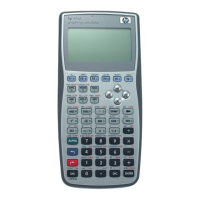3-110 Full Command and Function Reference
•
Creating a new copy of an object that originated in a larger composite object (such as a list)
allows you to recover the memory associated with the larger object when that larger object is
no longer needed.
Access: !°
MEMORY NEWOB ( °is the left-shift of the Nkey).
Flags: Last Arguments (-55). In order for NEWOB to immediately release the memory occupied by the
original copy, flag -55 must be set so that the copy is not saved as a last argument.
Input/Output:
Level 1/Argument 1 Level 1/Item 1
obj
→
obj
See also: MEM, PURGE
NEXT
Type: Command
Description: NEXT Command: Ends definite loop structures.
See the FOR and START keyword entries for more information.
Access: !°
BRANCH START/FOR NEXT ( °is the left-shift of the Nkey).
Input/Output: None
See also: FOR, START, STEP
NEXTPRIME
CAS: Return the next prime number larger than a given integer.
NIP
Type: RPL command
Description: Drops the (n–1)
th
argument, where n is the number of arguments or items on the stack. (that is,
the object on level 2 of the stack). This is equivalent to executing SWAP folowed by DROP in
RPN mode.
Access: !°
STACK LLNIP ( °is the left-shift of the Nkey).
I
STACK LLNIP
Input/Output:
Level 2 Level 1 Level 1
obj
1
obj
2
→
obj
2
See also: DUP, DUPDUP, DUPN, DUP2
NOT
Type: Function
Description: NOT Command: Returns the one
's complement or logical inverse of the argument.
When the argument is a binary integer or string, NOT complements each bit in the argument to
produce the result.
• A binary integer is treated as a sequence of bits as long as the current wordsize.
• A string is treated as a sequence of bits, using 8 bits per character (that is, using the binary
version of the character code).
When the argument is a real number or symbolic, NOT does a true/false test. The result is 1
(true) if the argument is zero; it is 0 (false) if the argument is nonzero. This test is usually done
on a test result (T/F).
If the argument is an algebraic object, then the result is an algebraic of the form NOT symb.
Execute
→NUM (or set flag –3 before executing NOT) to produce a numeric result from the
algebraic result.

